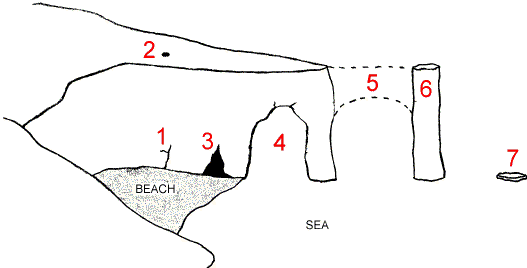
1. Joint or Fault in the resistant rock.
2. Blowhole – occasionally, water rises up through a vertical joint in the rock and is ejected through a blowhole.
3. Cave – abrasion and the hydraulic action of the waves widens the weaknesses in the cliff to form a cave.
4. Arch – waves cut through headland to form an arch which is continually being widened at its base by the force of the waves surrounding it.
5. Roof of an arch becomes too heavy to support and collapses.
6. Stack – an isolated portion of the cliff.
7. Stump – the stack is undercut and collapses leaving a stump.
The processes of wave erosion are as follows:
- Abrasion – a “saw” effect. Beach material is hurled / thrown against the cliffs. This is caused by the force of the waves which are in turn caused by the wind etc…
- Hydraulic Action – a “hammer” effect. Water compresses air into cracks on the cliffs and forces them wider.
- Corrosion / Solution – chemical decomposition of the cliff. (acidic water etc…)
- Attrition – beach material is bashed together so it reduces in size.
